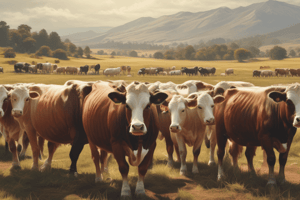Podcast
Questions and Answers
What is the average gestation period for a replacement heifer?
What is the average gestation period for a replacement heifer?
283 days
What percentage of calves are born in the spring?
What percentage of calves are born in the spring?
80%
What is the immediate care given to a newborn calf?
What is the immediate care given to a newborn calf?
Clear airways, disinfect navels, rub for circulation, and feed 2-3 liters of colostrum
What is the purpose of milk replacer in calf rearing?
What is the purpose of milk replacer in calf rearing?
What is the target weight for a replacement heifer at mating?
What is the target weight for a replacement heifer at mating?
What is the Body Condition Score (BCS) target at mating?
What is the Body Condition Score (BCS) target at mating?
What is the purpose of ear tagging ?
What is the purpose of ear tagging ?
What is the importance of colostrum in calf nutrition?
What is the importance of colostrum in calf nutrition?
What do housing require for animals?
What do housing require for animals?
What is the basis for selecting a bull for breeding?
What is the basis for selecting a bull for breeding?
Flashcards are hidden until you start studying
Study Notes
Life Cycle of a Replacement Heifer: Birth to 2 Years
Birth and Early Care
- Gestation period of a heifer is 283 days
- 80% of births occur in the spring
- Immediate care involves clearing airways, disinfecting navels, rubbing for circulation, and feeding 2-3 liters of colostrum
Calf Rearing
- Feeding sequence: colostrum, natural milk, milk replacer, and finally concentrates, hay, and grass
- Milk replacer prevents milk loss and helps avoid scour when fed regularly
Housing
- Housing should be clean, well-ventilated, draught-free, and provide clean bedding and water
Weaning
- Leader-follower grazing system promotes selective grazing and disease prevention
Overwintering (9 Months)
- Heifers are fed good quality silage with 75% DMD and dosed for hoose
Year 2 (Replacement Heifer)
- Selection criteria for replacement heifers include genetic merit, replacing lower yield cows, and a BCS of 3.25 at mating
- Target weight for replacement heifers is 300-330kg
- Feed consists of grass and silage with 75% DMD ad lib
- Importance of farm safety, adhering to safety measures
Key Practices
- Ear tagging is essential for identification and BVD control
- Housing should be clean, dry, well-ventilated, and provide adequate space
- Health management involves vaccination, dosing, and foot care
- Farm safety is crucial, with emphasis on safe practices in handling and managing livestock
Nutritional Management
- Colostrum is high in antibodies, providing crucial passive immunity
- Regular feeding of milk replacer prevents digestive issues
- Gradual introduction of concentrates, hay, and grass for rumen development
Selection of Replacement Heifers
- Criteria for selection include genetic merit, body condition score, and target weight
- Bull selection is based on Economic Breeding Index (EBI) and sub-indexes
Body Condition Score (BCS)
- BCS scale ranges from 1 to 5, with 1 being underweight and 5 being overweight
- Target BCS at mating is 3.25
Studying That Suits You
Use AI to generate personalized quizzes and flashcards to suit your learning preferences.




